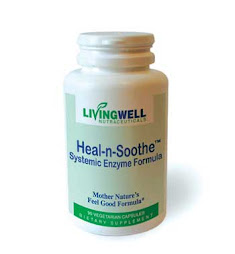Red, burning, swollen and so stiff you don't want to move... that's what those who suffer from arthritis experience on a daily basis. If you know this all to well, you are probably one of the 46 million Americans (that's 1 out of every 5 people) that are living with arthritis every day. To better understand how to get relief from this debilitating disease we need to dive deeper into its root cause.
Some of the types of arthritis which are associated with inflammation include:
* rheumatoid arthritis
* gout
* tendinitis
* bursitis
* polymyalgia rheumatica
What is Arthritis?
Arthritis actually means joint (arthr) inflammation (itis). Arthritis can be used to define a group of more than 100 rheumatic diseases and other conditions that can cause pain, stiffness and swelling in the joints or any part of your body.
Additionally, it can damage the joint cartilage which can lead to joint weakness, instability and visible deformities that can interfere and, in severe cases, limit a person's ability to perform most basic daily tasks such as walking, climbing stairs, using a computer keyboard, washing dishes or brushing your teeth.
Arthritis can affect anyone regardless of age and most commonly affects joints in the knees, hips, hands and spine. If left undiagnosed and not treated properly, arthritis can cause irreversible damage to the joints, bones, organs, and skin. Not to mention dramatically impair your quality of life.
Arthritis-related conditions primarily affect the muscles and the bones but it is also considered to be systemic, affecting the whole body. Arthritis can cause damage to any bodily organ or system, including the lungs, kidneys, blood vessels, skin and even the heart. The Arthritis Foundation sites two independent studies (Brigham and Women's Hospital in Boston and at the Mayo Clinic in Rochester, Minnesota) both of which prove that the widespread inflammation in rheumatoid arthritis is linked to heart disease and an increased risk of early death.
No one really knows the exact cause of arthritis but there are certain risk factors to keep in mind:
* Genetics - likely to contribute to risk but no one knows
how much.
* Age - the older you are the more at risk you become.
* Weight - maintaining a healthy weight will ease the load on
the joints.
* Previous Injury - major injuries are likely to contribute to
risk.
* Occupational Hazards - repetitive, high demand jobs increase
risk.
* Certain Sports - high level, high demand sports can
contribute to arthritis (however, general exercise is always
a plus)
* Illness or infection - an infection in the joint or gout can
lead to arthritis.
What we do know is that when you have arthritis your immune system goes into over-drive and causes the joints to swell and become inflamed. Therefore, treating the inflammation becomes key in managing the pain and discomfort associated with this condition.
Sadly enough, the Arthritis Foundation reports that half of those Americans with arthritis don't believe anything can be done to help ease their pain. You may be in that situation yourself, having thrown your hands up in frustration and simply decided to live with your pain. The good news is that by reducing the inflammation you
can significantly ease the painful symptoms associated with arthritis.
Here are a few ways to reduce your inflammation:
* Exercise - less weight equals less stress on joints
* Diet - Eat plenty of vegetables, fruits and whole-grain
products; limit sugar, salt and fat (especially saturated fat
found in animal products)
* Rest - a good balance between rest and activity is the key to
joint health
* Over-the-counter and prescription medications - while these may
provide temporary relief by masking the pain they are not always
get to the root of the problem - inflammation. They can also
have serious side effects, especially with long-term use.
* Natural anti-inflammatory supplements - probably the most
promising natural approach to reducing inflammation in a long
while. We recommend looking for supplements containing systemic
enzymes and all-natural herbal ingredients.
By taking these simple steps to reducing inflammation you will be well on your way to managing your arthritis pain and it devastating effects on your mind and body. Everyone should strive to achieve a healthy and
active lifestyle for optimal health and wellbeing.
| Finally... A Safe, Effective, All Natural Pain Reliever Dan Monahan had reached the point where he was willing to try anything - anything to ease the constant pain and inflammation in his leg. He could no longer walk. Even standing was uncomfortable. His doctor gave him several prescription medicines but nothing helped. Pain was ruining his life. When Dan saw an ad for this natural pain reliever, he was skeptical. How could this product work when every prescription his doctor gave him hadn't? But he decided to give it a try. Let Dan tell you what happened: "Was I pleasantly surprised! After only 2 to 3 days on the activation dose, I noticed reduced inflammation and less pain in my leg." After just three weeks, Dan started walking again. This all natural product worked for Dan when all of his prescription drugs hadn't. You can relieve your constant, burning pain when prescription drugs no longer work - just like Dan did - with Heal-n-Soothe. That's because Heal-n-Soothe works differently than prescription drugs. Here's how: Prescription drugs reduce inflammation by switching off important compounds your body needs. Many are vital to your health. Eventually, you may need more drugs to get the same relief. Or worse, you experience dangerous side effects caused by drugs that are supposed to help you feel better. Heal-n-Soothe works with nature by adding more of the enzymes that naturally reduce inflammation. With Heal-n-Soothe, your body has everything it needs to repair and renew your muscles and joints. You have less pain as a result - with no life threatening side effects. So if you're in constant pain and prescription drugs no longer help,don't wait another second. Click here to ease your pain and cool inflammation with Heal-n-Soothe! |




